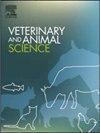Prevalence and molecular analysis of Sarcocystis species infection in slaughtered cattle in Alborz, Iran
IF 1.9
Q2 AGRICULTURE, DAIRY & ANIMAL SCIENCE
引用次数: 0
Abstract
Several species of Sarcocystis as an obligatory intracellular protozoon have been identified in cattle, including Sarcocystis cruzi, Sarcocystis hirsuta, and Sarcocystis hominis, whose definitive hosts are canids, felids, and humans respectively; these zoonotic parasitic species impose a financial and health burden on the livestock industry annually. The aim of the present study, which was conducted for the first time in Alborz province, was to determine the species of Sarcocystis based on macroscopic observation, digestion method and restriction fragment length polymorphism (RFLP)-PCR in slaughtered cows in this province in order to complete the information puzzle of the prevalence of Sarcocystis species in Iran and the world cattle.
In the present cross-sectional study, totally 138 samples of slaughtered cows in Alborz province industrial slaughterhouses were collected from diaphragm muscles and examined by macroscopic, digestive and molecular PCR-RFLP methods. This molecular-based method uses variations in homologous DNA sequences (polymorphism) of a population or species or to determine the precise locations of genes in a sequence. Fifty samples were randomly selected for DNA extraction and molecular analysis and sequencing for species identification. Macroscopic examination of the samples showed no cysts, but according to the digestion test results, 100 % of the samples were infected with Sarcocystis microcysts. The results of electrophoresis of PCR products showed a band of about 930 bp. The PCR products were digested with restriction enzyme (BFaI) and their digested pattern was evaluated. The results showed that all 50 samples were infected with Sarcocystis. After enzymatic digestion of primary PCR products, it was found that (47/50) 94 % and (3/50) 6 % the samples were infected with S. cruzzi and S. hirsuta species, respectively. No infection was found with S. hominis. Cattle slaughtered in Alborz province are highly infected with the Sarcocystis parasite, which can affect public health and animal health. The present study suggests that Sarcocystis spp. should be diagnosed by relying on high-precision diagnostic methods in order to improve food safety.
伊朗Alborz屠宰牛中肌囊虫感染的流行及分子分析
牛中已发现了几种作为细胞内原生动物的肌囊虫,包括克氏肌囊虫、毛状肌囊虫和人肌囊虫,它们的最终宿主分别是犬科动物、猫科动物和人类;这些人畜共患寄生虫每年给畜牧业造成财政和健康负担。本研究首次在阿尔布尔斯省开展,目的是通过宏观观察、消化法和限制性片段长度多态性(RFLP)-PCR对该省屠宰牛的肉囊菌种类进行确定,以解决伊朗和世界牛中肉囊菌种类流行的信息谜题。本横断面研究采用宏观、消化和分子PCR-RFLP方法,对阿尔布尔斯省工业屠宰场屠宰的138头牛的横断面肌肉样本进行了检测。这种基于分子的方法利用种群或物种的同源DNA序列(多态性)的变化或确定序列中基因的精确位置。随机抽取50份样本进行DNA提取、分子分析和测序,进行物种鉴定。样品肉眼检查未见囊肿,但根据消化试验结果,100%的样品感染了肉囊菌微囊。PCR产物电泳结果为一条约930 bp的条带。PCR产物用限制性内切酶(BFaI)酶切,并评价其酶切模式。结果显示,50份样本均感染了肉囊菌。对初代PCR产物进行酶切后,发现克氏单胞菌感染率为(47/50)94%,毛毛单胞菌感染率为(3/50)6%。未发现人型链球菌感染。在阿尔博尔斯省屠宰的牛高度感染了肉囊虫寄生虫,可影响公共卫生和动物健康。本研究提示,应依靠高精度的诊断方法对肉囊菌进行诊断,以提高食品安全。
本文章由计算机程序翻译,如有差异,请以英文原文为准。
求助全文
约1分钟内获得全文
求助全文
来源期刊

Veterinary and Animal Science
Veterinary-Veterinary (all)
CiteScore
3.50
自引率
0.00%
发文量
43
审稿时长
47 days
 求助内容:
求助内容: 应助结果提醒方式:
应助结果提醒方式:


